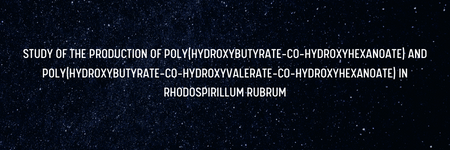Discover the last article of UMons !

Study of the Production of Poly(Hydroxybutyrate-co-Hydroxyhexanoate) and Poly(Hydroxybutyrate-co-Hydroxyvalerate-co-Hydroxyhexanoate) in Rhodospirillum rubrum
ABSTRACT
Poly(hydroxybutyrate-co-hydroxyhexanoate) [P(HB-co-HHx)] and poly(hydroxybutyrate-co-hydroxyvalerate-co-hydroxyhexanoate) [P(HB-co-HV-co-HHx)] demonstrate interesting mechanical and thermal properties as well as excellent biocompatibility, making them suitable for multiple applications and notably biomedical purposes. The production of such polymers was described in Rhodospirillum rubrum, a purple nonsulfur bacteria in a nutrient-lacking environment where the HHx synthesis is triggered by the presence of hexanoate in the medium. However, the production of P(HB-co-HHx) under nutrient-balanced growth conditions in R. rubrum has not been described so far, and the assimilation of hexanoate is poorly documented. In this study, we used proteomic analysis and a mutant fitness assay to demonstrate that hexanoate assimilation involve β-oxidation and the ethylmalonyl-coenzyme A (CoA) (EMC) and methylbutanoyl-CoA (MBC) pathways, both being anaplerotic pathways already described in R. rubrum. Polyhydroxyalkanoate (PHA) production is likely to involve the de novo fatty acid synthesis pathway. Concerning the polymer composition, HB is the main component of the polymer, probably as acetyl-CoA and butyryl-CoA are intermediates of hexanoate assimilation pathways. When no essential nutrient is lacking in the medium, the synthesis of PHA seems to help maintain the redox balance of the cell. In this framework, we showed that the fixation of CO2 is required to sustain the growth. An increase in the proportion of HHx in the polymer was observed when redox stress was engendered in the cell under bicarbonate-limiting growth conditions. The addition of isoleucine or valerate in the medium also increased the HHx content of the polymer and allowed the production of a terpolymer of P(HB-co-HV-co-HHx).
IMPORTANCE
The use of purple bacteria, which can assimilate volatile fatty acids, for biotechnological applications has increased, since they reduce the production costs of added-value compounds such as PHA. P(HB-co-HHx) and P(HB-co-HV-co-HHx) have demonstrated interesting properties, notably for biomedical applications. In a nutrient-lacking environment, R. rubrum is known to synthesize such polymers when hexanoate is used as the carbon source. However, their production in R. rubrum in non-nutrient-lacking growth conditions has not been described so far, and the assimilation of hexanoate is poorly documented. As the carbon source and its assimilation directly impact the polymer composition, we studied under non-nutrient-lacking growth conditions the assimilation pathway of hexanoate and PHA production in R. rubrum. Proteomic analysis and mutant fitness assays allowed us to explain PHA production and composition. An increase in HHx content of the polymer and production of P(HB-co-HV-co-HHx) was possible using the knowledge gained on metabolism under hexanoate growth conditions.